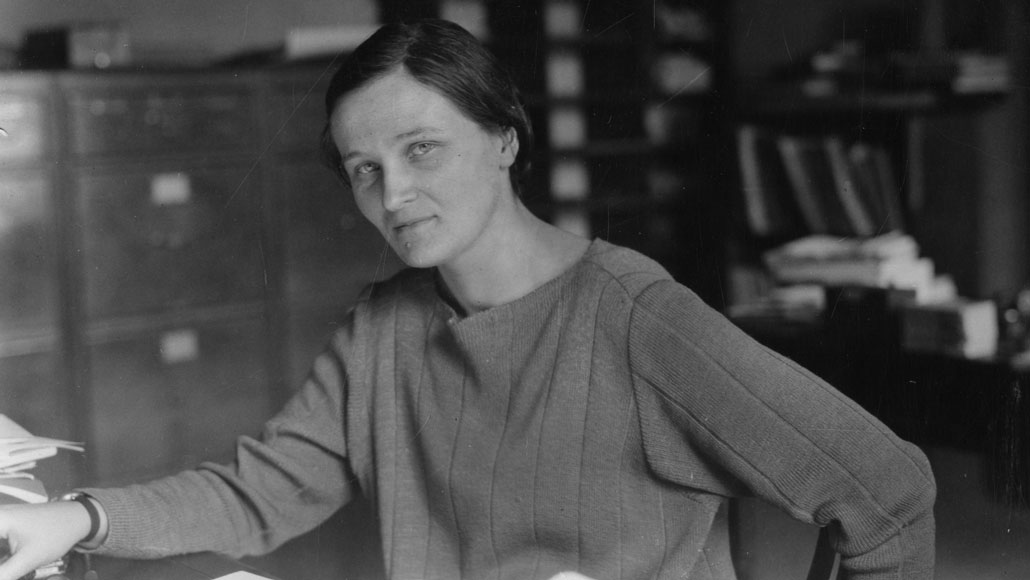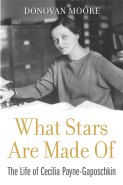
Cecilia Payne-Gaposchkin, seen at her desk at Harvard College Observatory, discovered that stars are made of mostly hydrogen and helium.
Smithsonian Institution Archives/Wikimedia Commons
- More than 2 years ago
What Stars Are Made Of
Donovan Moore
Harvard Univ., $29.95
It was 1924, and Cecilia Payne-Gaposchkin was on the verge of a breakthrough. Faint rainbows of starlight, recorded on photographic glass, held secrets to how the universe was put together. If only she could read the starlight’s story.
As with every other challenge in her life, Payne-Gaposchkin would not stop. She once went without sleep for 72 hours, struggling to understand what the stars were telling her.
“It was an impatience with the ordinary — with sleep, meals, even friendships and family — that had driven her as far back as she could remember,” journalist Donovan Moore writes in his book celebrating the life of Payne-Gaposchkin (who added “Gaposchkin” to her name upon marriage in 1934). After her death in 1979, other scientists would go on to remember her as “the most eminent woman astronomer of all time.” During a time when science was largely a men’s club, she had figured out the chemical makeup of the stars.
In What Stars Are Made Of, Moore takes readers on a meticulously researched tour of Payne-Gaposchkin’s remarkable life, drawn from family interviews, contemporary accounts and Payne-Gaposchkin’s own writings. It’s a riveting tale of a woman who knocked down every wall put before her to get the answers she desired about the cosmos.
Growing up in England, her love of science started before she could read. But English society in the early 1900s didn’t know what to do with such a determined girl. Days before her 17th birthday, she was told to leave school after administrators found they couldn’t meet her insatiable need to learn math and science. During physics lectures at the University of Cambridge, she, like all women, had to sit at the front, forced to parade past male students stomping in time with her steps.
And yet, she persisted, becoming a woman of firsts. In 1925, Payne-Gaposchkin became the first person to receive a Ph.D. in astronomy from Radcliffe College in Cambridge, Mass. In 1956, she was the first woman to be promoted to full professor at Harvard and several months later was the first to chair a department at the university.
Her big breakthrough came not long after finding work at Harvard College Observatory in 1923. She had taken it upon herself to analyze the institution’s library of stellar spectra: starlight broken into its component colors, revealing elements in the stars based on which wavelengths of light were missing.
The trouble was, no one had yet combed through the spectra to take a census of the atoms. Doing so required using the new field of quantum physics to identify dozens of element signatures in thousands of spectra — a task to which Payne-Gaposchkin was uniquely suited. The work was grueling and tedious, demanding she harness her keen observational skills, sharp mathematical mind and rigorous physics training.
After roughly two years of nearly unbroken focus, she overturned one of the prevailing thoughts of the day: that stars were chemically similar to Earth. Instead, hydrogen appeared to be a million times as abundant as expected, and helium a thousand times so. Earth, it seemed, was not the template for the universe.
At the time, Payne-Gaposchkin’s findings were largely dismissed as spurious. It wasn’t until the American astronomer Henry Norris Russell came to the same conclusion years later that minds started to change.
While opinions about her work were slow to change, progress in opinions toward women was glacial. Payne-Gaposchkin taught at Harvard for nearly two decades before being listed in the course catalog. Yet, her hunger for knowledge never stopped. A student once marveled at “her views on Italian art, or paleolithic axes, or mosaic woodworking, or the earliest printed edition of Reynard the Fox,” Moore writes.
Payne-Gaposchkin is the lead character of Moore’s book. But the book is also a tale of early 20th century science and the barriers that all women at the time faced. Anyone interested in any of these topics will revel in this book’s detail.
As for Payne-Gaposchkin, while she was aware of these barriers, she didn’t see herself as a feminist pioneer. She was drawn to the stars, and the stars were blind to gender. “She did not consider herself a woman astronomer,” Moore writes. “She was an astronomer.”
Buy What Stars Are Made Of from Amazon.com. Science News is a participant in the Amazon Services LLC Associates Program. Please see our FAQ for more details.








